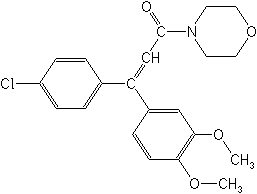-
Common NameDimethomorph
-
中文通用名烯酰吗啉
-
IUPAC(EZ)-4-[3-(4-chlorophenyl)-3-(3,4-dimethoxyphenyl)acryloyl]morpholine
-
CAS4-[3-(4-chlorophenyl)-3-(3,4-dimethoxyphenyl)-1-oxo-2-propenyl]morpholine
-
CAS No.110488-70-5
-
Molecular FormulaC21H22ClNO4
-
Molecular Structure
-
Category
-
ActivityFungicide.
Dimethomorph has protectant and curative activity, but is best used as a prophylactive in disease control programmes. Application intervals should be 10-14 days. It controls soil- and air-borne oomycete diseases. It is locally systemic and exhibits translaminar activity following foliar application. Dimethomorph is rainfast and has residual activity. The product can also be applied as a soil drench for root uptake. Dimethomorph controls all actively growing stages of fungi of the order Peronosporales, especially potato late blight. It is known to interfere with the formation of cell walls but the exact biochemical target has not yet been identified. In field trials, alcohol ethoxylate adjuvants have been shown to enhance the activity of the fungicide against downy mildew.
The company recommends that dimethomorph is not used alone in disease control programmes to delay the onset of resistance. Crops should be treated with combination products, tank mixes or in sequence with other products, e.g. mancozeb. The product is non-phytotoxic to target crops and safe to beneficial insects. -
CropUseCrop uses:
vines, potatoes, tomatoes, tobacco, vegetables
Vines
300 g ai/ha
-
PremixPyraclostrobin+dimethomorph
Propineb+Dimethomorph
fluoride ether bacteria amide+Dimethomorph
Fluazinam+dimethomorph
Famoxadone+Dimethomorph
Dithianon+Dimethomorph
Dimethomorph+Propamocarb hydrochloride
Dimethomorph+Oxine-copper
Dimethomorph+Metiram
Dimethomorph+Metalaxyl
Dimethomorph+mancozeb
Dimethomorph+Copper calcium sulphate
Dimethomorph+Benziothiazolinone
Dimethomorph+ametoctradin
Cuprous oxide+Dimethomorph
Chlorothalonil+dimethomorph
Azoxystrobin+Dimethomorph
Dispersible concentrate, suspension concentrate, wettable powder. Premix Parters: tetradifon.Type
AI concn
Wettable powder (WP)
50% (w/w)
?
25% (w/w)
Dispersible concentrate (DC)
15% (w/v)
-
Physical PropertiesMolecular weight:387.9; Physical form:Colourless to grey crystalline powder. Density:Bulk density 1318 kg/m3 (20 °C); Composition:(E)- to (Z)- ratio is c. 1:1. Melting point:127-148 °C; (E)- isomer 135.7-137.5 °C; (Z)- isomer 169.2-170.2 °C; Vapour pressure:(E)- isomer 9.7×10-4 mPa; (Z)- isomer 1.0×10-3 mPa (both 25 °C); Partition coefficient(n-octanol and water):logP = 2.63 (E)- isomer; 2.73 (Z)- isomer (both 20 °C); Solubility:In water 19 ( pH 5), 18 ( pH 7), 16 ( pH 9) (all in mg/l, 20 °C). In acetone 88 (E), 15 (Z), cyclohexanone 27 (Z), dichloromethane 315 (Z), dimethylformam; Stability:Hydrolytically and thermally stable under normal conditions. Stable for >5 years in the dark. The (E)- and (Z)- isomers are interconverted in sunlight.
-
ToxicologyOral:Acute oral
LD50 for male rats 4300 mg/kg, female rats 3500 mg/kg, male mice >5000 mg/kg, female mice 3700 mg/kg b.w. Percutaneous:Acute percutaneous LD50 for rats >5000 mg/kg b.w. Not irritant to skin or eyes of rabbits. Not a skin sensitiser (guinea pigs). Inhalation: LC50 (4 h) for rats >4.2 mg/l air. ADI:( ) 0.002 mg/kg b.w. (sum of dimethoate and omethoate -
Environmental ProfileEcotoxicology:?
Algae:EC50 (96 h) >20 mg/l.Bees:Non-toxic to honeybees at 0.1 mg/bee (contact or oral, highest dose tested).Birds:Acute oral LD50 for mallard ducks >2000 mg/kg. Dietary LC50 >5300 ppm.Daphnia: EC50 (48 h) 49 mg/l.Fish: LC50 (96 h) for bluegill sunfish >25, carp 14, rainbow trout 3.4 mg/l.Worms: EC50 for earthworms >1000 mg/kg soil.?
Environmental fate:?
Animals:In rats, the major route of metabolism is demethylation of one of the dimethoxy groups or by oxidation of one of the CH2 groups (ortho- or meta- position) of the morpholine ring. The major route of excretion was the faeces.Soil:Moderately mobile (Kd 2.09-11.67 ml/g, Koc 290-566). Aerobic soil metabolism 50 66-117 d; no degradates identified except for CO2.Plant:The only significant component of the residue, when present, is the parent compound.
WATER SOLUBILITY: 18 mg/l at 20°C (pH 7).
Mallard duck
LD50 >2,000 mg/kg
Bluegill sunfish [96 hrs]
LC50>25 mg/litre
Bobwhite quail
LD50 >2,000 mg/kg
Rainbow trout [96 hrs]
LC506.8 mg/litre
Carp [96 hrs]
LC50 18 mg/litre
Fate in soil:
The half-life of dimethomorph is 14-50 days. The compound has low soil mobility and is not expected to leach.Fate in aquatic systems:
Dimethomorph is slowly degraded by photolysis in water. -
Transport InformationSignal Word:CAUTION; Hazard Class:III (Slightly hazardous)
Porduct NewsMore
Sapec Agro Italia presents fungicide product lines ALMADA
Australia approved 13 ais registrations (Special gazette, 9 December 2014)
Quinoxyfen Dimethomorph Trifloxystrobin Isoxaflutole Glufosinate-ammonium Hexazinone Fipronil Clothianidin Thiram Prothioconazole Thiacloprid Chlormequat chloride
Related CompaniesMore
SINO CHEMTECH (SHANGHAI) CO., LTD
Country: China
Tribenuron-methyl Nicosulfuron Dimethomorph Clodinafop-propargyl Diazinon Emamectin benzoate Imidacloprid Thiamethoxam Chlorpyrifos+cypermethrin Bromoxynil octanoate+MCPA-isooctyl BAAPE IR3535
Anhui Fengle Agrochemical Co., Ltd.
Country: China
Tribenuron-methyl Dimethomorph Bentazone Carboxin Quizalofop-P-ethyl Nicosulfuron Clomazone Propiconazole Chlorpyrifos Clopyralid Clodinafop-propargyl
Hebei Guanlong Agrochemical Co.,Ltd
Country: China
Thiram Ziram Captan Dimethomorph Flusilazole Acetamiprid Iprodione Difenoconazole Prochloraz Azoxystrobin
Shanghai Heben-Eastsun Medicaments Co., Ltd.
Country: China
Thiamethoxam Azoxystrobin Boscalid Chlorfenapyr Difenoconazole Fludioxonil Indoxacarb Picoxystrobin Pyraclostrobin Tebuconazole
SINO AGRO-CHEMICAL INDUSTRY LTD.
Country: China
Prothioconazole Azoxystrobin Pyraclostrobin Methoxyfenozide Bifenazate Bispyribac-sodium Nicosulfuron Tebuconazole Pyribenzoxim Penoxsulam

 0
0 Subscribe
Subscribe
